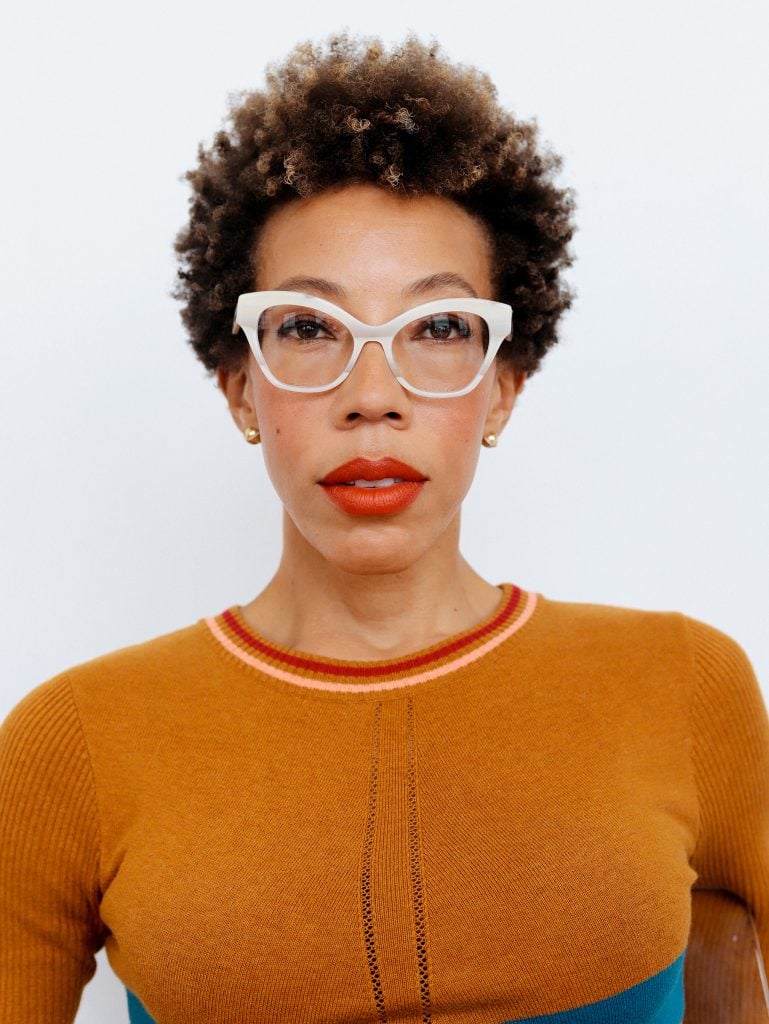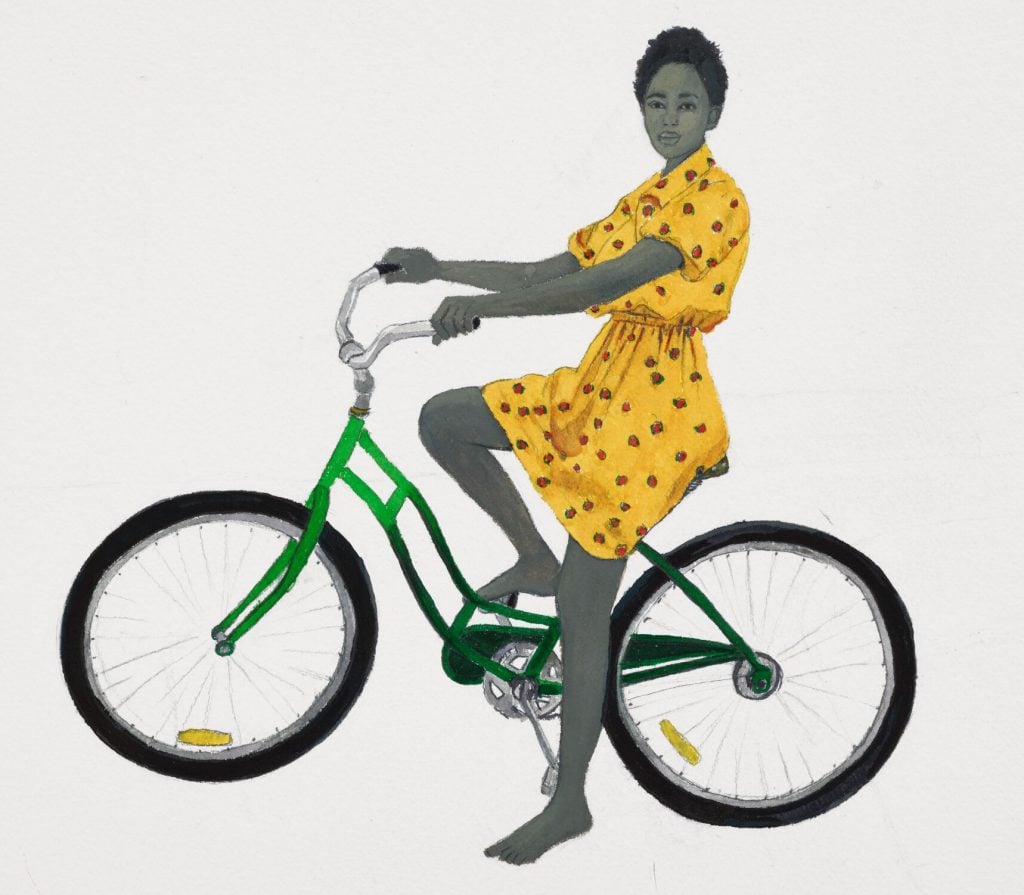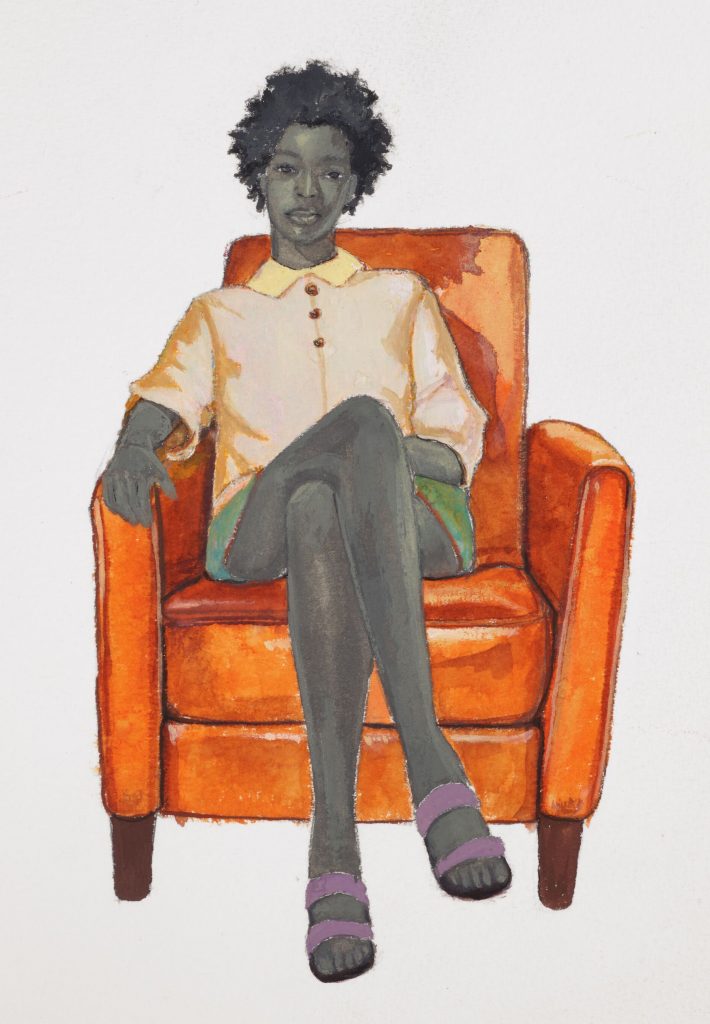People
‘It Came Down to What I Could Make at My Kitchen Table’: Amy Sherald on Experimenting With a New Medium for the First Time in Decades
Hauser & Wirth is hosting an online show of the new work next week.

Hauser & Wirth is hosting an online show of the new work next week.

Colony Little

On October 19th, Hauser and Wirth gallery will present a series of five new paintings by artist Amy Sherald in an online exhibition titled “Womanist is to Feminist as Purple is to Lavender.” The title draws from a phrase attributed to Alice Walker and her exploration of “womanist” ideology, which accounted for the intersectional experiences of Black women left out of established feminism, in the anthology titled In Search of Our Mothers’ Gardens, from 1983.
In these new paintings, Sherald conducts an examination of identity analogous to Walker’s, experimenting with new materials and themes that celebrate femininity, self-awareness, and leisure through the prism of Blackness. In doing so, the artist reveals expressions of Black life that have been historically absent in Black imagery. She presents simple acts of leisure that are not luxuries of privilege or passive pursuits, but essential elements of wellness that remind us of the restorative power of joy.
Amy Sherald approaches social portraiture with an intentionality that is expressed in the unique characteristics of her paintings. Her grey skin tones have become abstractions of blackness that reject social stratifications that underlie racism and colorism. Sherald paints her subjects on solid color backgrounds that accentuate the contrasting shades of their clothing and the lush texture of their natural coifs. Her intentionality extends to the visual parity the artist creates in the leveled gaze between the subject and viewer, asserting her subject’s rightful place in the pantheon of portraiture.
Taken together, these artistic devices subvert narrow social constructs around blackness while maintain the essence of its beauty. Her work has earned her the critical and popular acclaim that led to her 2018 portrait of First Lady Michelle Obama in the National Portrait Gallery and, most recently, a commission for a portrait of Breonna Taylor featured that became Vanity Fair‘s September cover. Hauser and Wirth’s online exhibition precedes a new solo presentation of Amy Sherald’s work set for February 2021 at Hauser and Wirth in Los Angeles.
Recently, Sherald took precious time out of her schedule to reflect on the new work, Breonna Taylor, caregiving, and creating art during the global pandemic with Artnet News contributor Colony Little.

Amy Sherald, Untitled (Detail) (2020). © Amy Sherald, Courtesy the artist and Hauser & Wirth.
The title of this exhibition, “Womanist is to Feminist as Purple is to Lavender” is a nod to Alice Walker’s famous exploration of womanist theory. How did this quote inform your latest series? There are multiple nuanced interpretations of womanist ideology. What does womanism mean to you as a Black woman and an artist?
I was thinking about a title for this show and I came across it after the work was finished. It’s rare that I go into the studio responding to words or with words in my head. But when I am finished with the work, I like to read poetry and books that connect organically to the themes I’m exploring. I extract phrases or piece together different sentences from various readings. I look to some of my favorite women writers because I can always find the work in their words.
I’m not sure that as a black woman you can be a feminist. They are the same, but different, as Walker writes. As purple is to lavender. A Womanist works to ensure the well-being of men, women, and all of humanity. It’s not singular and I like that.
How did you choose the subjects for these five portraits?
I keep an archive of images I’ve collected over the past decades and I scrolled through it to find some inspiration in photographs from older shoots that I never gave birth to as paintings. It wasn’t on purpose but the ones that really struck me just happened to be photos of women. So yes, these are real women that I’ve documented in the past and now got to study a little more closely.
The smaller scale of the works, the return to gouache, and your choice of background color is a departure from earlier paintings, yet it remains indelibly you. Can you describe the impetus behind these slight alterations in your material and process? Are there any aesthetic details or clues that will offer viewers insights into the new work you will exhibit in your 2021 solo show in LA?
It really came down to what I could make at my kitchen table, which is where I worked on these as the weeks passed. I have not worked in gouache since I was in elementary school. I never enjoyed it and always dreaded having to finish assignments with it because as a medium its challenging to control.
My art teacher from kindergarten through 12th grade, Geri Davis, was and is a master at gouache. I think back to how patient she was with it and probably how patient she told me to be with it. I remember being frustrated at an early age. You’re still learning how to draw and then you get something good down and you want to add some color to it. You pull out the watercolor and before you know it, everything is all messed up and blurred.
As I sat down to make the first one after perfecting the drawing, I had that same anxiety about messing it up and having to start all over again. And wait for it… I did! But luckily, I, like everyone else, had nothing else to do but start over.
That’s not completely true, of course, because I was with my 84-year-old mother and my sister who had just had major surgery. So these portraits were made in sneak-away moments and when I wasn’t prepping and preparing 3 meals a day and caregiving. I did end up making one of the works into a larger painting for my solo show in Los Angeles this winter.

Amy Sherald, Untitled (Detail) (2020). ©Amy Sherald, Courtesy the artist and Hauser & Wirth.
Your portraits tend to focus on a three-quarter length view of your subjects. In this new series we see a full-length painting of a woman with a bicycle and a seated woman in a bright orange chair. What do you attribute this shift in perspective to?
Working on a smaller scale and with gouache, I had the opportunity to think about locating these women in spaces of privacy and pleasure, and what it means to access rest and relaxation when so much else is going on around us. I wanted to offer images of recreation as something playful and regenerative.
Can you share a piece of literature, an album, or a film that has offered you solace during these unprecedented times and has also left an indelible mark on the work you are creating right now?
Nothing that I have read or watched is really finding itself into my work at the moment. I’ve been too distracted to read honestly.
I’ve been watching The Sinner, and Little Fires Everywhere. I’ve also been following a lot of news and reflecting on this watershed moment. The virus, the local and global protests, which may not have even happened without the virus. The fact that the virus snatched away so many people who would otherwise still be here. It’s almost as if they were kidnapped. The new challenges we face as a society. This election will leave an indelible mark on this country.
I’ve been thinking about Breonna and my grandmother who I learned as a kid died in a hospital waiting room after hemorrhaging during childbirth. She was at a whites only hospital—the Black hospital was too far—and they turned her away. The fact that no one was held accountable for her death or the death of the baby. I’ve been thinking about how we carry trauma in our cells and how to leave a legacy of trauma behind and focus on pleasure. I’ve been thinking about accountability.
Maybe all of these things will at some point find their way into the work. But I don’t think so because it’s so convoluted and I paint the things I wish to see.